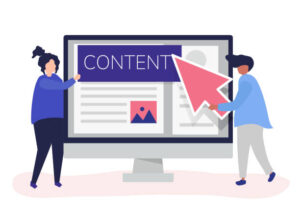Creating content is hard. Between staying true to your brand values, cultivating engagement, and being creative, you’ve got your hands full. Even harder yet is keeping your content fresh across platforms. Why is content optimization so important and how do you do it? Let’s examine!
Selecting the Right Platforms For Content Optimization

Part of the challenge of consistently creating engaging content is selecting the right platforms. You have to not only know who your customers are and what they want but also where they spend their time. The latter part is especially important; you don’t want to be wasting time creating content few people will see or interact with.
Selecting the right platforms for your content goes beyond posting on Facebook, Instagram, or Twitter. It’s choosing the most effective media types to raise brand awareness, drive engagement, and engineer more conversions. That means taking advantage of things like videos, blogs, events, and even interactive content.
For example, maybe a blog would help interested customers move closer to making a purchase. But creating and implementing a blog on its own isn’t going to move the needle. What you need is content optimization. That means creating the blog post as part of a series directed at specific customer personas–and supplementing it via other platforms and channels.
Content Optimization Tips
The most important thing to remember about content optimization is that you’re creating content not for your brand but for your audience. That means what you find interesting might be boring to your audience. Know your customers inside and out. That means knowing what they want, why they want it, and who they want to be. You’ll get more people interested in your content, which will ultimately drive more folks through the conversion funnel!

In terms of content optimization, be sure you’re using the right platform for its intended purpose. For instance, blog posts don’t belong on Twitter. A blog would be better suited to your website, supplemented by links and posts on Facebook or Instagram. The actual copy itself stays on your website.
Another way to keep your content fresh and interesting is to lead with emotion. Whether that’s humor, empathy, or something in between, getting your customers emotionally involved is the key to creating an effective relationship with your brand. After all, emotion is the most important driver of purchasing decisions! Look to connect with your customers beyond their wallets and create emotionally-driven content.
Properly optimized content is effective content. If you plan your content optimization strategy in advance, however, you’ll be able to stick to your calendar to help create an effective plan. For example, you might want to improve website traffic and unique visitors–content optimization will help ensure all the content you create aligns with these goals.
Don’t Forget About User-Generated Content!
The best part about user-generated content is you don’t have to create it yourself. The next best thing is, if properly optimized and implemented, it can be more effective than branded content.

Plus, user-generated content shows that there are others with a connection to your brand. Real customer testimony is many times more likely than any brand messaging to inspire other customers to take action because it’s impartial. Why else would word of mouth advertising be so effective? While customers may doubt the authenticity of branded statements and messages, they’re more likely to believe the objectivity of a random customer who isn’t being paid to create that content.
User-generated content captures the attention of both your brand’s followers and the creator’s following, which means it’s a great way to boost your visibility! While you might not be able to nab a big-time influencer to create content on your brand’s behalf, sometimes quantity can trump quality. In other words, if you can create buzz around your brand from average people, it’ll be just as effective as if you landed a celebrity spokesperson!
No Content is Bad Content
Your brand can’t survive if your customers aren’t aware you exist. You also can’t expect to build a relationship with customers without having a personality for your brand–a personality you build through effective content marketing. Your content tells your customers not only what you do but who you are and why you do it, both of which are significantly more important than what products or services you offer.
Unless your content is out of left field, hypocritical, or contradictory, it’s probably not bad content. But if you can optimize your cross-channel content to drive customers through your conversion funnel, you’ll essentially be automating the sales process and building relationships simultaneously!








